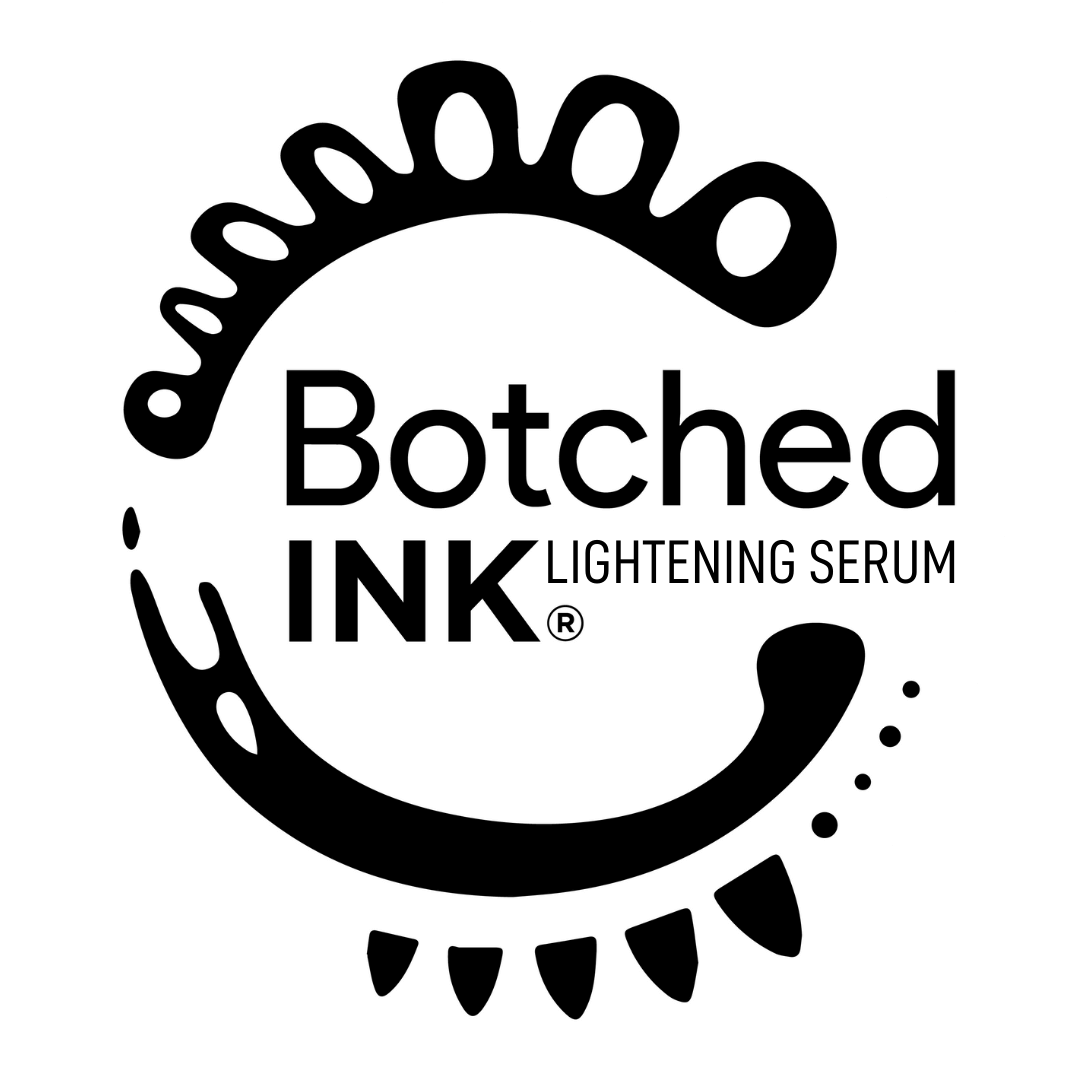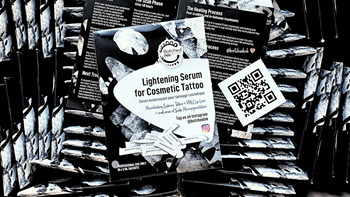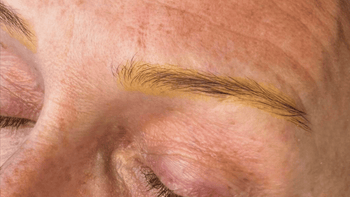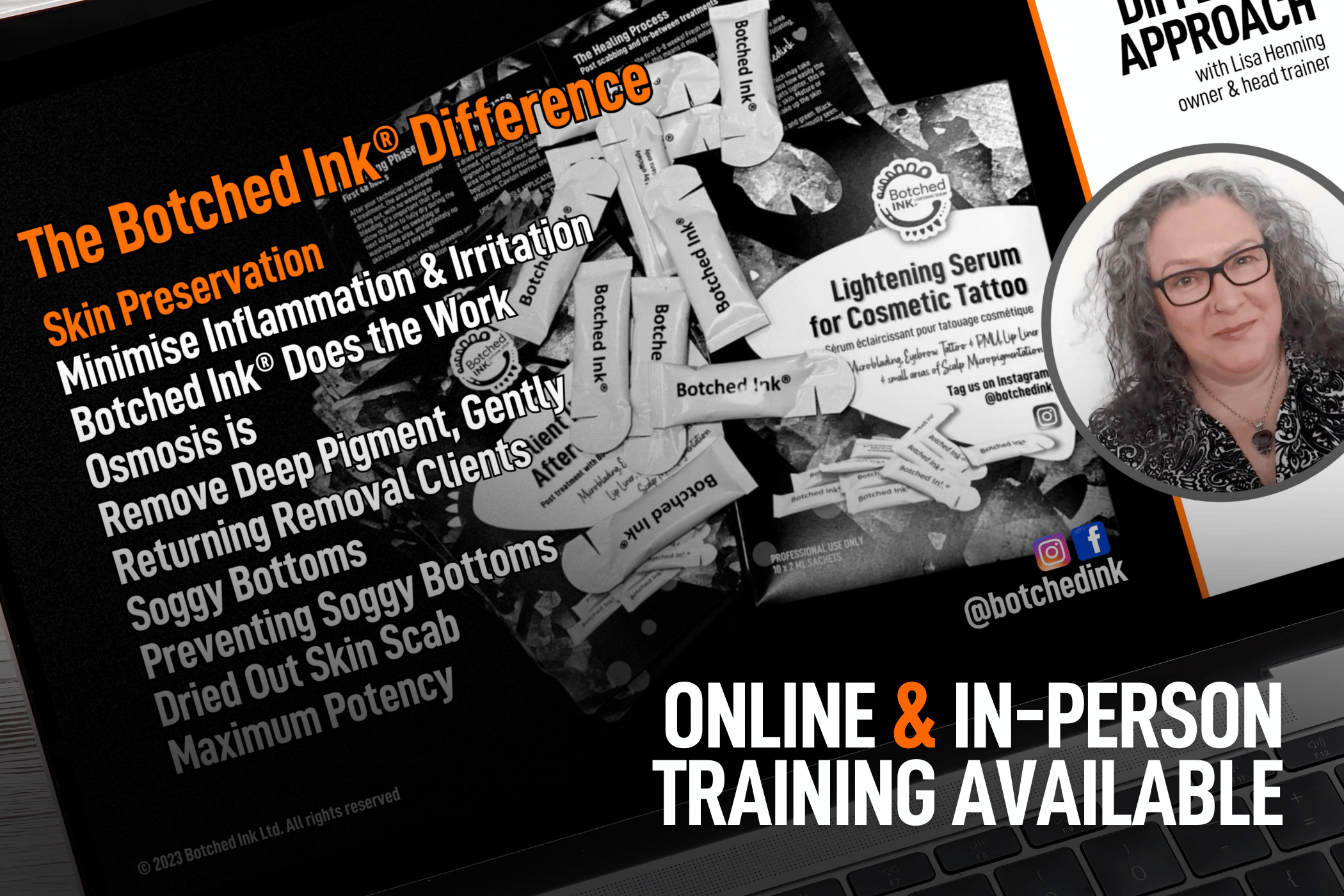Introduction
Chemical tattoo removal often sounds tempting, stronger, faster, and marketed as a shortcut to lift pigment. But what’s the real story when acids like glycolic, lactic, or alkaline solutions are tattooed into the skin?
In this article, I’ll explain how chemical tattoo removal really works, why it often carries higher risks for the skin, and how Botched Ink® offers a gentler, more predictable alternative.
Thanks for being here!
Lisa 🧡

TL;DR
Chemical tattoo removal with glycolic or alkaline solutions can remove microblading and permanent makeup, but it comes at a cost. A 30% glycolic acid that gives a light peel on your face reacts very differently when it’s tattooed into the skin. For tattoo removal, acids must reach the dermis, causing deep trauma, thick scabs, inflammation, and a higher risk of scars or lasting skin discolouration.
What is Saline Tattoo Removal? ➔
Find a Botched Ink® Tech Near You ➔
Chemical Tattoo Removal Products
There are several branded chemical tattoo removal methods in the PMU industry, each built around acids or alkaline solutions:
PhiRemoval – glycolic acid (AHA)
Tatt2Away – lactic acid (AHA)
Angel Removal – mixed acids
Rejuvi – the original alkaline solution
MM Removal – acid + alkaline blend
Magnetic Removal – friction with an alkaline solution
Different names, same principle: these aren’t surface peels, they’re tattooed into your skin. That means trauma to the dermis, inflammation, and scabs that heal out with pigment inside them, but also a higher risk of scars or skin colour changes.
Eyebrow Tattoo Removal: Saline or Laser ➔
Permanent Makeup Removal: Pigments ➔
Professional Responsibility
For professionals, using any tattoo removal method comes with clear responsibilities. Chemical removers in particular demand caution:
Know your solution
You should fully understand the ingredients, how they interact with skin, and what risks they carry. Using a product without this knowledge risks long-term damage to your clients.
Individual assessment
Every client’s tattoo is different. Factors like pigment depth, skin tone, age of tattoo, and presence of scar tissue all influence outcomes. Chemical removers are not one-size-fits-all.
Set realistic expectations
Clients must know that acids and alkalines don’t dissolve ink, and that healing can be long, unpredictable, and sometimes leave permanent texture changes. Overpromising results is one of the fastest ways to lose trust.
Aftercare guidance
Because chemical removers create deeper trauma, strict aftercare instructions are not optional. Clients should leave knowing exactly how to protect their skin, especially from infection and UV exposure.
Botched Ink® makes this easier. Its saline-based system is designed to work with the skin rather than against it, with predictable healing and clearer aftercare. Professionals using Botched Ink® are not only offering a safer service, they’re building trust by putting skin health first.
Chemical Tattoo Removal vs Chemical Peels
The names sound similar, but the treatments couldn’t be more different.
Chemical peels are designed for surface exfoliation. A 5–10% glycolic or trichloroacetic acid peel gently removes dead cells from the top layer of skin, improving texture and tone. The acid stays superficial, it never reaches the dermis where tattoo pigment sits. That’s why peels are considered safe refreshers for most skin types, with only light peeling and minimal downtime.
Chemical tattoo removal, on the other hand, has to reach pigment embedded in the dermis. To do this, acids like glycolic or lactic, or alkaline powders like calcium oxide, are tattooed into the skin at far higher concentrations. This isn’t gentle exfoliation, it’s controlled trauma. The result? Thick scabs, inflammation, prolonged healing, and a much higher risk of scars or skin discolouration.
Key takeaway: a chemical peel brightens skin on the surface; chemical tattoo removal deliberately injures the skin to push pigment out. They are not the same procedure.

How Chemical Tattoo Removal Really Works
A common misconception is that chemical tattoo removal “dissolves” pigment. It doesn’t. The acids or alkaline agents don’t break ink down on a molecular level, they damage the skin around the pigment. As the skin heals, a scab forms, and some pigment is carried out in that scab.
This trauma can cause effects that look dramatic but are often misunderstood:
Brown residue: Sometimes the skin bleeds slightly during treatment. When blood oxidises, it turns brown, easily mistaken for pigment being expelled. In reality, it’s damaged skin and dried blood, not ink.
Frosting: The temporary white colour some clients see isn’t pigment dissolving, it’s the proteins in the skin reacting to the chemical. It’s a sign of skin trauma, not pigment breakdown.
So while chemicals can lift pigment, they do it by forcing a wound, not by safely dissolving ink.
Key takeaway: what comes out of the skin after chemical removal isn’t proof the ink has been “melted away”, it’s the result of skin damage and scabbing.
Ingredients Used in Chemical Tattoo Removal
Different brands use different acids or alkaline powders, but the way they work, and the risks, are similar.
Glycolic acid
A strong alpha hydroxy acid (AHA). At high concentrations, it penetrates deeply, breaking down the bonds between skin cells. This can lift pigment but also causes irritation, thick scabs, sun sensitivity, and scarring risk, especially on facial skin.
Lactic acid
A gentler AHA used in skincare, but in tattoo removal it still requires repeat trauma to reach pigment. Over multiple sessions the cumulative irritation can cause frosting, texture changes, and permanent discolouration.
Salicylic acid
A beta hydroxy acid (BHA) that penetrates pores and dries out the skin. In tattoo removal it can cause excessive flaking, irritation, and prolonged healing, with higher risk of scarring.
Alkaline compounds
(calcium oxide, zinc oxide, magnesium oxide)
These raise the skin’s pH and bond with pigment, forming hard crusts that expel colour as they heal. The downside is uneven healing, thick scabs, discomfort, and long-term scarring or texture changes.
Combination formulas
Some brands mix acids and alkalines, or add peel agents like retinol or hyaluronic acid. These can lift pigment faster, but at the cost of deeper skin disruption, extended recovery, and unpredictable results.
Key takeaway: acids and alkalines don’t safely dissolve pigment, they create trauma so pigment is forced out, leaving the skin at risk.

Healing & Aftercare: Chemicals vs Botched Ink®
How the skin heals after removal is just as important as how much pigment is lifted.
Chemical tattoo removal
High concentrations of acids or alkaline powders create deep trauma. The result is thick, uncomfortable scabs, prolonged sensitivity, and higher risks of scars or permanent pigment changes. Aftercare has to be strict, keeping the area dry, avoiding sun, and watching closely for infection or irritation. Even then, results can be patchy, with uneven colour left behind.
Botched Ink® saline removal
Works with the skin’s healing. The process creates a controlled wound and lighter scabbing, so recovery is tidier and less disruptive. Clients can expect less swelling and discomfort, and aftercare is simpler. The skin looks and feels calmer, and the risk of permanent texture changes is far lower.
Key takeaway: chemical methods force heavy trauma and long recovery; Botched Ink® supports the skin to heal predictably and safely.
Sun Sensitivity After Chemical Removal
One detail often overlooked is how chemical removers affect the skin’s relationship with the sun. Acids like glycolic or lactic don’t just exfoliate, they strip away natural protection. When tattooed into the dermis at high concentrations, they leave fresh, vulnerable skin exposed for weeks.
This means UV protection isn’t optional, it’s essential. Without sunscreen and careful avoidance of direct sun, the treated area can develop hyperpigmentation (dark patches) or hypopigmentation (light patches). Even clients with darker skin tones are at risk, as inflammation combined with UV exposure can trigger long-lasting colour changes.
Key takeaway: acid-based tattoo removers don’t just affect what comes out of the skin — they change how the new skin reacts to the environment. Sun protection becomes a critical part of aftercare.

Deep Tattoos & Long-Term Skin Health
The depth of the tattoo makes a big difference to both results and healing.
Superficial tattoos & microblading
Pigment placed closer to the surface is easier to reach, so chemical removers don’t need to penetrate as deeply. The skin may still scab heavily, but the risk of long-term texture change is lower than with deeper ink. Even so, acids and alkaline agents often cause unnecessary trauma compared with saline.
Deep or saturated tattoos
Pigment embedded in the dermis, or layered over years of top-ups, requires stronger formulas and multiple sessions. This means more aggressive penetration, thicker scabs, longer healing times, and a much higher risk of permanent scarring or uneven results.
Facial skin vs body tattoos
Facial tattoos and PMU are more delicate, and scar tissue or fibrotic layers can trap pigment where laser light can’t reach. Forcing aggressive chemicals through these barriers risks patchy colour and lasting sensitivity.
Tattoo removal creams
Despite marketing claims, over-the-counter creams can’t reach tattoo pigment, which is held at various levels in the skin. At best they irritate the surface, at worst they burn and scar, leaving the skin in worse condition without shifting deeper pigment.
Key takeaway: shallow pigment may come out more easily, but deeper ink almost always demands harsher chemicals — and harsher healing. Botched Ink® lifts pigment from both deep and superficial layers by working with the skin’s natural repair, preserving long-term texture and tone.
Key Considerations & Safer Choices
Choosing a tattoo removal method isn’t just about how quickly pigment can be lifted, it’s about what condition your skin is left in.
Chemical removers like glycolic acid or alkaline powders do force pigment out, but only by creating deep trauma. That means strict aftercare, longer recovery, and a real risk of scarring or uneven colour. They may look fast on paper, but the hidden cost is often permanent damage to skin texture and tone.
Botched Ink® saline removal works differently. It creates a controlled wound that heals predictably, with lighter scabbing, shorter downtime, and a far lower risk of permanent texture changes. That makes it especially suited to brows, lips, and other sensitive areas where skin quality matters most. And if black pigment remains afterwards, laser can still be used more gently once Botched Ink® has already lifted the rest.
Key takeaway: chemical methods might lift ink, but they fight the skin in the process. Botched Ink® works with the skin, protecting long-term skin health while still giving you the results you want.

Chemical Tattoo Removal FAQs
Does chemical tattoo removal work?
Chemical tattoo removal can lift pigment, but it does so by damaging skin cells rather than dissolving ink. Acids and alkaline agents force pigment upward through scabbing, which may lighten tattoos but often leads to thick scabs, irritation, or scarring, especially on brows or lips.
Does glycolic acid work for tattoo removal?
Glycolic acid is best known as a skin peel or exfoliator, not a tattoo remover. When it’s tattooed into the skin, especially into deeper pigment layers, it becomes harsh and traumatic. The acid breaks down healthy skin cells to push pigment out, often leaving thick scabs, irritation, and possible scars.
Is chemical tattoo removal safe?
Chemical tattoo removal isn’t considered safe for most clients. Acids such as glycolic, lactic, or salicylic, and alkaline compounds, can lift pigment but also create deep trauma and inflammation. These treatments risk scarring and discoloration, particularly on delicate areas like brows and lips.
What’s the difference between a chemical peel and chemical tattoo removal?
A chemical peel used in skincare involves mild acids (around 5–10%), or stronger peels up to 30%, applied to the surface to improve tone and texture. Chemical tattoo removal uses much higher concentrations tattooed into the dermis to reach pigment, causing deeper trauma, thick scabs, and a higher chance of scarring.
What does frosting mean in tattoo removal?
Frosting is the temporary whitening that appears after chemical tattoo removal. It happens when acids or alkaline agents coagulate proteins in the skin, a sign of tissue trauma, not pigment dissolving. Persistent frosting indicates over-processing and a higher risk of scarring.
What chemicals are used to remove tattoos?
Common chemicals include glycolic acid, lactic acid, salicylic acid, and alkaline compounds such as calcium oxide or zinc oxide. These don’t dissolve ink; they damage skin cells so pigment is expelled through scabbing. This process carries a high risk of scarring and uneven texture.
What chemicals fade tattoos?
Acids and alkaline agents can fade tattoos by breaking down skin layers around the pigment. Results are unpredictable, and skin damage or discoloration is common. Saline tattoo removal with Botched Ink® is a safer, more predictable alternative for lightening or removing pigment.
What’s the safest chemical-free alternative?
The safest alternative to chemical tattoo removal is saline tattoo removal. Botched Ink® creates a controlled wound that gently lifts pigment while protecting skin health. It produces lighter scabs, faster recovery, and far fewer risks for sensitive areas like brows and lips.
Where to Go From Here
If you’ve made it this far, you know the reality: chemical tattoo removers like glycolic acid can lift pigment, but they do it by wounding the skin. Botched Ink® was developed as a gentler alternative — saline removal designed for results and skin health.
For clients: If you’re considering removing or lightening cosmetic tattoos, choose a method that works with your skin, not against it. Our Find a Tech Map connects you with trained Botched Ink® technicians worldwide.
For professionals: If you want to offer a safer option than chemical tattoo removers in your clinic, enrol in our online training or in-person model class. You’ll learn the Botched Ink® method directly from the brand that created it.
Saline Tattoo Removal Training ➔
Botched Ink® is more than just a saline solution. It’s a full system, training, education, and ongoing support, built on trust and skin safety. Whether you’re a client or a professional, you’ll always have guidance every step of the way.
Thanks for reading,
Lisa 🧡
Owner and developer of Botched Ink®






